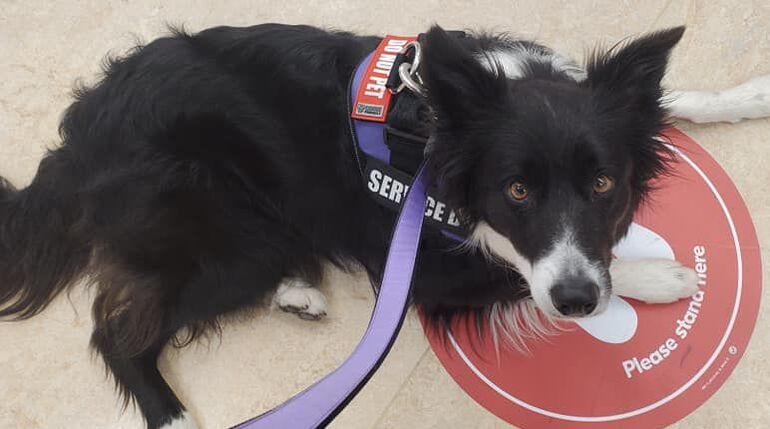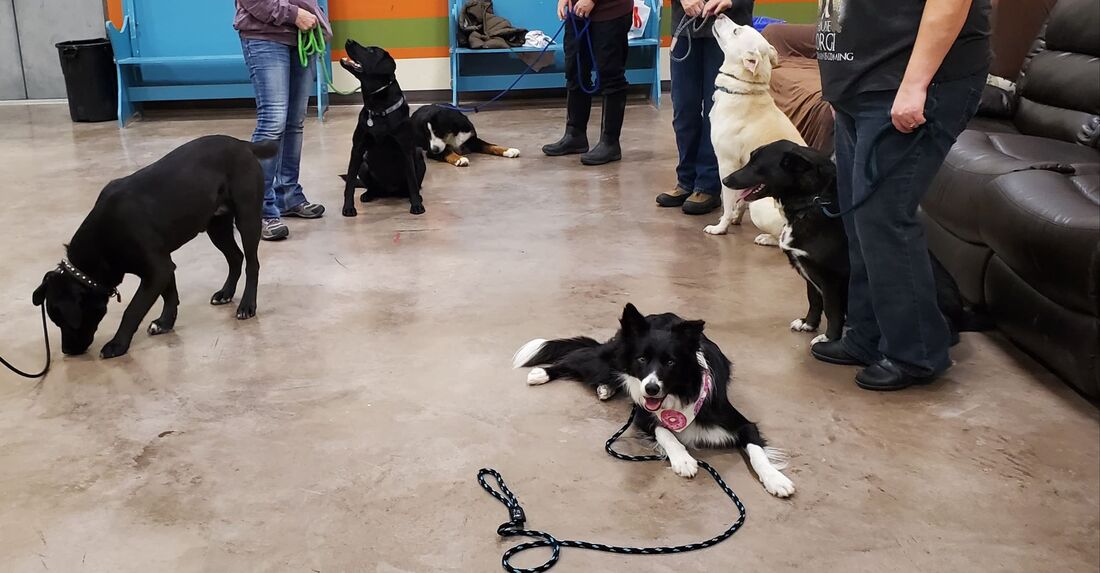|
A service dog is a specially trained dog who provides assistance to a person with a disability. Think of these dogs as the equivalent of a wheelchair or an oxygen machine, imperative for their handler but should be mostly ignored by everyone else.
Where are they allowed? Pretty much everywhere. With a couple exceptions (kitchens or surgical rooms) they have total access to any public space including restaurants, medical clinics, and even airplanes. Remember they are medical equipment, nobody just leaves their pacemaker at home. How can you tell? I'm glad you asked! Alberta is special in the way that we have a provincial test to certify service dogs which makes it really easy for businesses to know. Each team is then given an ID card which is government issued and individual to the team. NOTE there are fake registries for certifying pets that are not trained for work, these are not valid and you should not accept anything that isn't government issued, or these pets can present real dangers to the public. What is required? First of all the handler must be permanently disabled. This includes physical disabilities, like epilepsy or being wheelchair bound, and psychological disabilities such as severe anxiety or PTSD. A doctor must sign a form indicating a dog would be helpful for your circumstances. Next the dog must be checked by a vet to ascertain they are fit for duty. Training is done in a couple ways, either by a program or the owner can train the dog. Once a dog is trained they are tested by a master service dog trainer to ensure they are up to standard, and then they are a full service animal! If you own a business you are encouraged to ask teams you meet, 1. Is this a service animal? 2. Do you have Alberta government ID? If it's a no to either access can be denied. If any animal INCLUDING certified service animals, is behaving poorly in your business (harassing people, making excess noise, disturbing product, etc.) you are legally allowed to ask the team to leave. Otherwise if you see a service dog in public please ignore them so they can do their job. No touch, no talk, no eye contact, no noises. You can smile to the owner but otherwise leave them be. They're there for a reason and they know they're adorable.
0 Comments
Fireworks are fun right? Everyone loves a red and white display on Canada Day... except for your pets. The majority of pet dogs (and cats) are nervous about fireworks, some to an extreme degree. Here are some suggestions to make sure everyone enjoys the festivities as much as possible.
-Tire them out before night comes. Go for a long walk or run to work off some nervous energy and set them up for calmness. - SECURE YOU PETS. This is so important: even if you don't think that your pets will react, keep them close. Bring pets inside well before dark, and if they need to go out for potty breaks, keep them on a leash. Even outdoor pets should be put inside somewhere safe, even a barn or shed, just so they won't run away and get into danger. - If you are camping, put them on a leash and a secure collar or harness that won't slip off, or put them inside the camper/tent so they don't get loose in a strange environment (I am seeing reports of dogs going missing already sadly). - Provide a comforting space. If you aren't out enjoying the festivities, keep your pet close because they will feel more comfortable with you. In either case have your pets hang out in an interior room with windows and doors closed. - If your pet is alone and comforted by being in a crate, you can cover it with a heavier blanket to mute sounds. - Turn on a TV or radio at a moderate level to cover the harsh cracking and popping sounds of fireworks. - Provide them with a bone or puzzle toy to focus on for the night and keep them happy during the night. - Check up on them frequently for stress signs: like panting, cowering, whining, drooling, barking, and hiding. If you see these signs dedicate more time to soothing them and taking their mind off of the fireworks. If you take good care of your animals this firework season; your pet will be safer and happier, you won't have to endure a missing animal, and you will both enjoy your summer more. While you're spending lots of time with your dog remember to exercise all parts of them: body, mind, behavior, and heart.
Body- Go for a walk, a run, or a swim! Aim for 30 minutes a day at least. A dog that can burn off energy in a healthy way will be happier. You will also notice that if your dog is getting regular exercise bad behaviors start to melt away. Try a few different things to figure out what your dog likes best; a leisurely stroll, a hike in the woods, a vigorous game of fetch, swimming in the lake, or running with a bike or quad. Mind- Dogs crave enrichment. Give them a fun puzzle toy or a kong stuffed with goodies. Let them work on something on their own and work out solutions. Letting them work through puzzles helps their brains develop so they will be more confident and independent thinkers. Behavior- Practice those skills you learned in class! You want to spend at least 15 minutes a day working with your dog on some behavior. The basics from obedience class, nosework, agility, tricks, grooming skills, or anything else you want them to learn. Training and teaching your dog builds your bond, helps them burn off energy, and helps you improve trouble areas. Heart- Spend some time loving up on your dog. Give them pets, praise, and cuddles. Take some time for some quiet time, teach them that hanging out and relaxing is good. If your dog knows how and when to relax you'll have a more peaceful home. There's so many different ways to love your dog and work with them. Providing a nicely rounded life will give you a happy and healthy dog. A leash isn't just a tether; it's a lightning rod. Everything you are feeling and expressing is telegraphing down the leash and being read by your dog. In some cases this sensitivity to emotion can be a good thing; a psychiatric service animal reading an oncoming panic episode in time to counteract it. But more often than not this sensitivity can lead to worsening of problem behaviors. Take a dog with a lack of confidence, add in some of your nerves, and you suddenly have a fearful or reactive dog just trying to take back some control of their situation. Its subconscious this tension but it is possible to learn to see it and to consciously counter it. Listen to yourself and watch your dog. If they seem flinchy, or watchful, or nervous look at what you are saying with your body. Are you clutching the leash close praying your dog doesn't react? Are you uncomfortable out for a walk and your head is on the swivel? Your dog sees these things, they survive by reading other creatures and acting accordingly, so he is taking notes on how you are acting. If you are scared, there MUST be something he should be scared of. If you are angry, you become something scary (even if it's not the dog you are upset with). It is your role as your dogs leader and protector to let him feel safe in the knowledge that "you got this" by being calm and in control even if you don't feel it 100%. Take a breath, loosen up your shoulders and your leash hand, straighten up, take an upbeat tone, and go forth boldly. If you can't feel calm take a break and lower your stress level, waiting until you feel back in control so that your dog doesn't feel the need to take back control for you. Our dogs mirror us in so many ways, make sure you like your reflection.
What does dog-to-dog socialization mean?
This picture right here is a group of dogs showing excellent socialization skills. Note, none of them are interacting with each other, they are interacting with their owners. Proper dog socialization means that your pup is able to think and work despite being in close proximity to other dogs. The approach of "socializing" meaning letting dogs play with each other makes for dogs with lower impulse control and a propensity for reactivity. Let me explain. A dog that is taught from square one that other dogs are SUPER EXCITING is going to get SUPER EXCITED every time he sees another dog. This excitement can include barking, howling, jumping, and lunging in desperation to see the SUPER EXCITING THING. The ears shut off and you've just lost control of your dog. There goes their recall, there goes their leave-it command, there goes everything you thought your dog was good at when at home. As they grow older this excitement can slip into the realm anxiety which in turn breeds reactivity. A dog who always feels TOO MUCH come across as too much, other dogs may not appreciate that which in turn could cause retaliation, and then teach your dog that social interactions are bad. But he is still too excited and now unsure, which often manifests as fear reactive behaviors. On the flip side, the approach I like to teach dogs and owners is that your number one approach to any dog-to-dog reaction should be a calm and relaxed mindset for both you and your dog. Dogs should learn to look to you for guidance, direction, and permission in social interactions with other dogs. They need to learn how to exist near other dogs long before they need to know about playing with them. In classes we don't encourage dog-to-dog interactions because we want to be the lighthouse of calm in a sea of canine chaos. Once they have learned the art of being calm and listening to you in intense environments, only then can we open the door to fun activities. We can introduce them to dogs that we know, dogs we have met before (maybe in obedience class) so they feel confident and you can feel confident you aren't running into a potentially reactive dog. Let them play but ask them to check in (and reward them for that) so that they remember you are there and they remember that you are their number one. A calm well balanced dog handles life a lot easier and is prone to fewer issues. |
AuthorAs Pied Piper's Trainer I am also an avid writer. Using these skills I'll be adding educational posts to this section. Archives
May 2021
|


